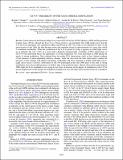GX 9+9: VARIABILITY OF THE X-RAY ORBITAL MODULATION
Author(s)
Harris, Robert J.; Durant, Martin; Kong, Albert K. H.; Charles, Phil; Shahbaz, Tariq; Levine, Alan M; ... Show more Show less
DownloadHarris-2009-GX 9+9_ VARIABILITY.pdf (697.0Kb)
PUBLISHER_POLICY
Publisher Policy
Article is made available in accordance with the publisher's policy and may be subject to US copyright law. Please refer to the publisher's site for terms of use.
Terms of use
Metadata
Show full item recordAbstract
Results of observations of the Galactic bulge X-ray source GX 9+9 by the All-Sky Monitor (ASM) and Proportional Counter Array (PCA) onboard the Rossi X-ray Timing Explorer are presented. The ASM results show that the 4.19 hr X-ray periodicity first reported by Hertz and Wood in 1987 was weak or not detected for most of the mission prior to late 2004, but then became strong and remained strong for approximately two years after which it weakened considerably. When the modulation at the 4.19 hr period is strong, it appears in folded light curves as an intensity dip over lsim30% of a cycle and is distinctly nonsinusoidal. A number of PCA observations of GX 9+9 were performed before the appearance of strong modulation; two were performed in 2006 during the epoch of strong modulation. Data obtained from the earlier PCA observations yield, at best, limited evidence of the presence of phase-dependent intensity changes, while the data from the later observations confirm the presence of flux minima with depths and phases compatible with those apparent in folded ASM light curves. Light curves from a Chandra observation of GX 9+9 performed in the year 2000 prior to the start of strong modulation show the possible presence of shallow dips at the predicted times. Optical observations performed in 2006 while the X-ray modulation was strong do not show an increase in the degree of modulation at the 4.19 hr period. Implications of the changes in modulation strength in X-rays and other observational results are considered.
Date issued
2009-05Department
Massachusetts Institute of Technology. Department of Physics; MIT Kavli Institute for Astrophysics and Space ResearchJournal
Astrophysical Journal
Publisher
Institute of Physics/American Astronomical Society
Citation
Harris, Robert J., Alan M. Levine, Martin Durant, Albert K. H. Kong, Phil Charles, and Tariq Shahbaz. “GX 9+9: VARIABILITY OF THE X-RAY ORBITAL MODULATION.” The Astrophysical Journal 696, no. 2 (April 28, 2009): 1987–1997. © 2009 American Astronomical Society.
Version: Final published version
ISSN
0004-637X
1538-4357